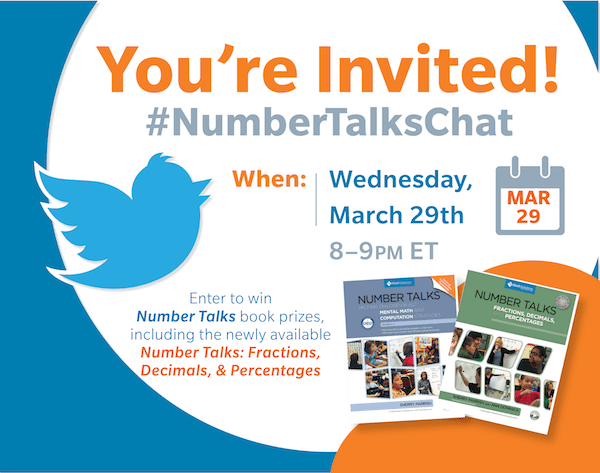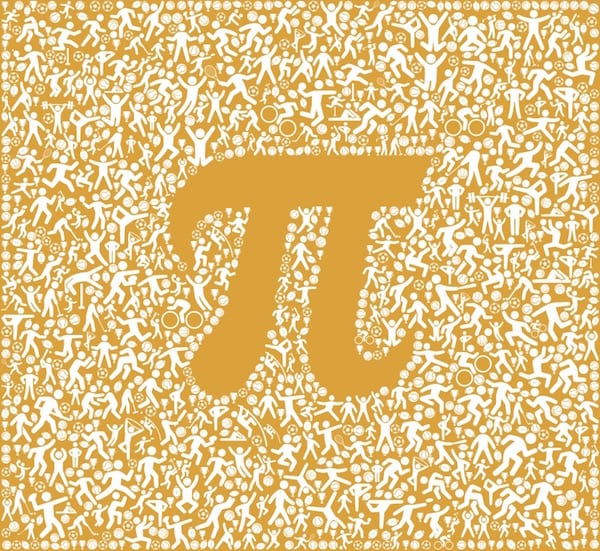Read on to discover lessons, articles, videos, and more. We update the blog regularly to provide you with valuable and timely resources, so visit us often!
Join Math Solutions for our March 2017 #NumberTalksChat
by March 17th, 2017
It’s time for another Twitter live chat on fractions, decimals, and percentages! Please join @Math_Solutions for our March #NumberTalksChat on Wednesday, March 29th at 8pm ET/ 5pm PT. Two lucky participants will be randomly selected to receive copies of Sherry Parrish and Ann Dominick’s Number Talks: Fractions, Decimals, and Percentages. Join us for a lively discussion on strategies…
Teacher Mindsets and Student Learning
by March 16th, 2017
On the first day of my Mathematics Methods course for preservice teachers, I ask my students to solve the Dealing in Horses Problem from Marilyn Burns’ book About Teaching Mathematics, Fourth Edition: I ask my students to consider the problem individually for a few minutes and then discuss and solve the problem in table groups. I…
Happy Pi Day: Book Giveaway
by March 14th, 2017
It’s that time of year again – time to celebrate pi! How are you celebrating Pi Day in your classroom? If you’re looking for Pi Day resources, we’ve got you covered. Check out Treve Brinkman’s Why We Celebrate Pi blog post, then check out a few of our pi-inspired lessons, including Measuring Circles and Finding…
Making Math Homework Count
by March 10th, 2017
What constitutes good and meaningful math homework? Through a rich bank of math homework assignments, teachers come to see how homework can reinforce skills, prepare students for future lessons, extend their mathematical knowledge, and inspire their creativity. Take this example: Homework: If 3 is 5% of a number, what is 30% of that number? …
Helping Struggling Students Build a Mathematical Mindset
by March 03rd, 2017
Recent research on mathematical mindsets is turning some long-standing beliefs about mathematics learning on their heads. These studies have important implications for classroom teachers and mathematics coaches. What do we want our students to know about mathematical mindsets? Here are three big ideas I recommend discussing, modeling, and cultivating in any mathematics learning setting: Everyone…
Beyond Pizzas & Pies: Interview with Julie McNamara
by February 28th, 2017
Today we’re thrilled to welcome Tara from The Elementary Math Maniac to the blog to share the second part of her interview with Julie McNamara, author of Beyond Pizzas & Pies and Beyond Invert & Multiply. You can read the first part of the interview on her blog. How did you go from being…
Crafting a Vision for Homework
by February 27th, 2017
Recently I read Matt Larson’s message on homework and reflected on how much my own stance on homework has evolved in the last decade. Initially, I struggled alone with creating homework, photocopying weekly packets, and spending hours checking and tracking what students did. Things improved when I worked with grade-level colleagues to carefully select questions…
Fraction Number Talks: An Interview with Sherry Parrish & Ann Dominick
by February 24th, 2017
We’re thrilled to welcome Kristin Gray, K-5 Math Specialist and author of Math Minds, to the blog today. She recently interviewed Sherry Parrish and Ann Dominick, authors of Number Talks: Fractions, Decimals, & Percentages, about their processes and experience as math educators. Both authors share how their careers in math education inspired their work with number talks,…
Halving Squares: A #FractionsFebruary Activity
by February 21st, 2017
An important mathematics concept for children to learn is that all halves of the same whole are the same size. If the whole is divided into different sizes, then they are not halves. While halves of the same shape must be the same size, they do not have to be the same shape. For example,…
#FractionsFebruary Activity: Ordering Fractions
by February 17th, 2017
When teaching fractions, it’s important to give students the opportunity to compare and order fractions, and practice equivalent and non-equivalent fractions. Try this activity for fourth and fifth-grade students who have already explored fractional parts of halves, fourths, eighths, and sixteenths. The lesson demonstrates students’ levels of comprehension, and helps them improve their reasoning skills. With the…










